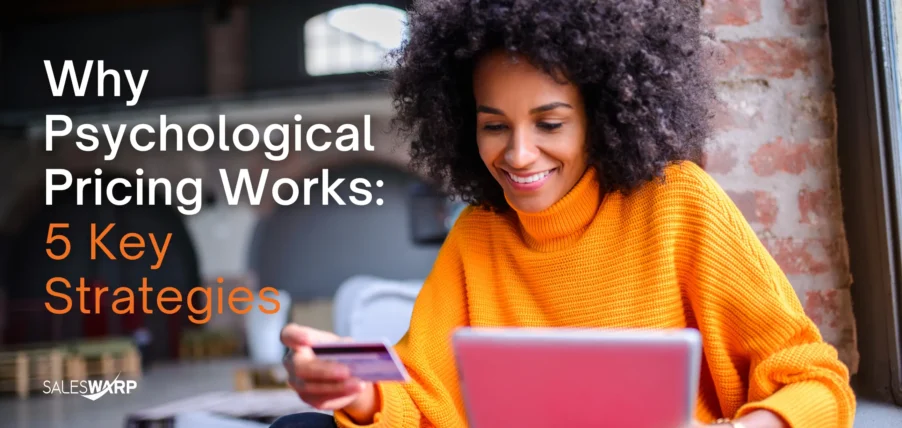Why Psychological Pricing Works: 5 Key Strategies
 Have you ever walked into a store, looking for something simple, when your eyes land on a price tag that reads $9.99 instead of $10.00? At first glance, it sounds like a better deal, right? This isn’t an accident—it’s a pricing strategy known as psychological pricing, designed to subtly shape how we perceive value and influence buying decisions.
Have you ever walked into a store, looking for something simple, when your eyes land on a price tag that reads $9.99 instead of $10.00? At first glance, it sounds like a better deal, right? This isn’t an accident—it’s a pricing strategy known as psychological pricing, designed to subtly shape how we perceive value and influence buying decisions.
The difference isn’t that significant, but our brains see the lower number as much cheaper. Why do tactics like this work? And how can businesses use them effectively?
What Is Psychological Pricing?
Psychological pricing is a strategy that uses pricing techniques to subtly influence consumer perception and behavior. By leveraging cognitive biases and psychological triggers, businesses can make prices appear more attractive, increase conversions, and maximize profitability.
These pricing tactics work because they tap into human psychology—our decision-making shortcuts (heuristics), perceptions of value, and emotional responses. Instead of analyzing every purchase logically, we often rely on gut feelings and visual cues to determine if a price is reasonable.
Why Psychological Pricing Works
Psychological pricing is effective because:
- It makes prices appear lower than they actually are (e.g., $99.99 instead of $100).
- It influences consumer decision-making subconsciously, reducing hesitation.
- It creates perceived value, making customers feel they are getting a deal.
- It drives urgency, encouraging customers to make quicker purchasing decisions.
- It enhances competitiveness, helping businesses stand out in the market.
By understanding how pricing affects customer perception, businesses can optimize their pricing strategies to boost sales and profitability.
5 Powerful Psychological Pricing Strategies
Now, let’s dive into five key psychological pricing tactics that businesses use to attract customers.
- Price Anchoring – The Power of Comparison
Price anchoring occurs when an initial price (the “anchor”) sets the reference point for consumers, making other prices seem like a better deal.
Why it works:
Customers naturally compare prices when making purchasing decisions. If they see an expensive option first, they are more likely to perceive a slightly lower-priced product as a bargain—even if it’s still costly.
Example: A jewelry store first shows customers a $5,000 diamond ring, followed by a $3,500 ring. The second ring feels more affordable in comparison, increasing the likelihood of purchase.
Best for: Businesses with tiered pricing models, such as SaaS companies, luxury goods, or subscription services.
- Charm Pricing – The Magic of .99
Charm pricing involves ending prices in “9” (e.g., $9.99, $19.99, $599.99) to make them seem significantly lower than the next whole number.
Why it works: Due to the left-digit bias, our brains process $9.99 as closer to $9 than $10, making it feel like a better deal—even though the actual difference is minimal.
Example: A streaming service offers a monthly plan for $7.99 instead of $8.00. Despite the tiny price difference, customers perceive it as cheaper.
Best for: Retailers, eCommerce stores, and subscription services looking to maximize conversions.
- Odd-Even Pricing – Deals vs. Luxury
Odd pricing (e.g., $19.97, $39.99) signals a discount or deal. Even pricing (e.g., $20.00, $50.00) conveys prestige and luxury.
Why it works: Odd prices are associated with discounts and affordability, while even prices feel rounded, complete, and premium.
Example: Nike prices high-end sneakers at $200.00 to emphasize luxury. Old Navy prices clothing at $19.97 to make them feel like a bargain.
Best for: Brands that want to position themselves strategically—luxury brands use even pricing, while discount brands use odd pricing.
- Decoy Pricing
Decoy pricing involves offering a strategic “inferior” option to nudge customers toward a preferred product.
Why it works: People tend to choose options that offer the best value for money. The “decoy” price makes one option stand out as the logical choice.
Example: A digital magazine offers three plans:
Online-only – $59
Print-only – $125
Online + Print – $125
Because the Print-only and Online + Print plans are the same price, customers feel like they are getting a better deal with the third option, making them more likely to choose it.
Best for: SaaS products, online subscriptions, and service-based businesses.
- Center Stage Effect
When presented with multiple options, customers tend to gravitate toward the middle option.
Why it works: People assume that the middle option offers the best balance between affordability and quality.
Example: A software company offers three pricing plans:
Basic – $9/month
Standard – $29/month (center stage option)
Deluxe – $79/month
By placing the Standard plan in the middle, customers naturally gravitate toward it, believing it offers the best value.
Best for: Subscription models, restaurants, and eCommerce businesses.
Psychological pricing is a powerful tool that can influence customer perception. The key is to understand your audience and product positioning—whether you want to promote affordability, exclusivity, or premium value. When applied correctly, the right pricing strategy can be the game-changer that sets your business apart from competitors.

